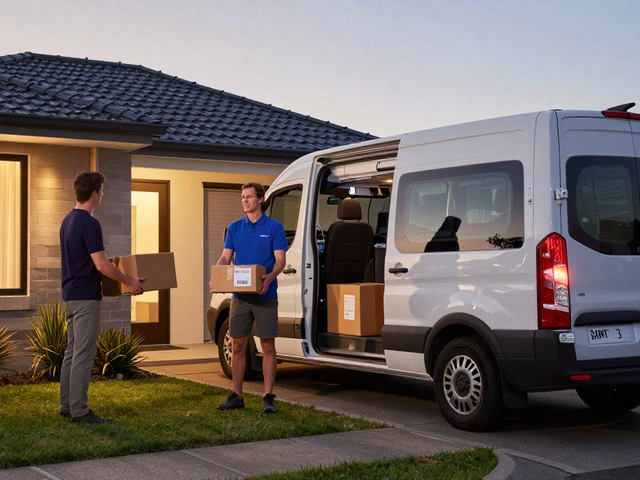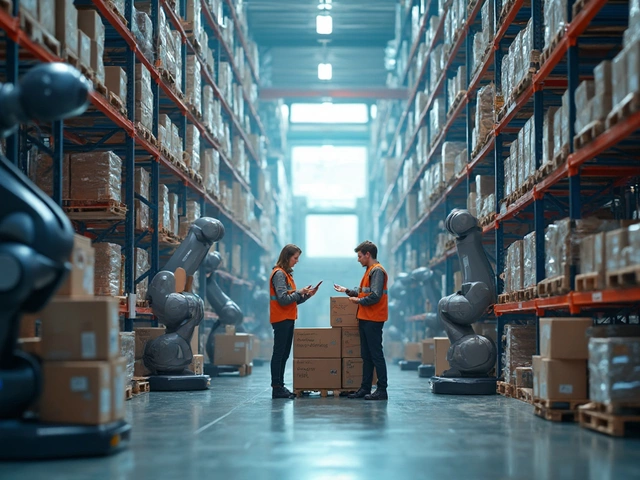Logistics vs e-Logistics Comparison Tool
Use this tool to compare traditional logistics and e-logistics based on key features. Select the features you value most to see how e-logistics can benefit your operations.
Features to Compare
Comparison Result
Logistics is a system that plans, implements, and controls the efficient movement and storage of goods, services, and related information from origin to consumption.
e-Logistics is a digitally enabled extension of logistics that leverages online platforms, cloud computing, IoT sensors and data analytics to provide real‑time visibility and automation across the supply chain.
Key Takeaways
- Traditional logistics relies on manual processes and paper‑based coordination.
- e‑Logistics integrates digital platforms, IoT devices, and data analytics for real‑time tracking.
- Both aim to move goods efficiently, but e‑Logistics adds speed, transparency and scalability.
- Adopting e‑Logistics often requires upgrading IT infrastructure and reshaping business processes.
- Companies that blend both approaches can achieve the best balance of cost and service.
Traditional Logistics: The Core Components
When people talk about logistics they usually picture trucks, warehouses, and a network of carriers. The discipline sits inside Supply Chain Management the broader practice of planning and controlling the flow of goods, information, and finances across the entire value chain. Within logistics, three pillars dominate:
- Transportation Management the planning and execution of moving freight by road, rail, sea or air.
- Warehouse Management the handling, storage and retrieval of inventory inside distribution centers.
- Freight Forwarding the coordination of international shipments, customs clearance and multimodal transport.
These functions traditionally run on spreadsheets, phone calls and faxed documents. While effective, the lack of real‑time data often leads to delays, mis‑placements, and higher operating costs.
e‑Logistics: The Digital Upgrade
e‑Logistics overlays the same core functions with technology. The engine behind it is a Digital Platform a cloud‑based software suite that connects shippers, carriers, warehouses and customers in a single interface. Key enablers include:
- IoT (Internet of Things) sensors attached to containers, pallets or vehicles that broadcast location, temperature and shock data.
- Real‑time Tracking instant visibility of shipment status on dashboards or mobile apps.
- Data Analytics algorithms that predict demand, optimise routes and flag exceptions before they become problems.
- Cloud Computing scalable infrastructure that stores massive data sets and runs analytics without on‑premise hardware constraints.
The result is a supply chain that can react in minutes instead of days. For example, if a temperature sensor detects a deviation, an automated alert can reroute the cargo or trigger a contingency plan instantly.
Side‑by‑Side Comparison
| Attribute | Logistics | e‑Logistics |
|---|---|---|
| Core Focus | Physical movement and storage | Physical movement plus digital integration |
| Technology Reliance | Low - manual paperwork, basic TMS | High - cloud platforms, IoT, AI |
| Data Visibility | Batch updates, lag hours | Real‑time, end‑to‑end traceability |
| Speed of Decision‑Making | Hours to days | Seconds to minutes |
| Cost Structure | Fixed operational costs, higher labor | Variable tech subscription, lower manual labor |
| Typical Users | Manufacturers, distributors, 3PLs | E‑commerce retailers, omni‑channel brands, tech‑savvy 3PLs |

Why Companies Shift to e‑Logistics
1. Improved Customer Experience - Consumers now expect live tracking, same‑day delivery options and instant order updates. e‑Logistics makes those promises possible.
2. Cost Savings - Route optimisation algorithms can cut fuel use by up to 15% (industry studies confirm). Automated inventory triggers reduce over‑stock and dead‑stock.
3. Scalability - During peak seasons, cloud platforms spin up extra compute power instantly, handling spikes without costly hardware upgrades.
4. Risk Reduction - Real‑time alerts let firms react to delays, temperature excursions or customs holds before they cascade.
5. Data‑Driven Insight - Analytics dashboards reveal bottlene‑points, carrier performance and demand trends, guiding strategic decisions.
Real‑World Illustrations
Amazon the e‑commerce giant that runs a massive network of fulfillment centers, robot‑enabled warehouses and a proprietary delivery platform uses e‑logistics at scale. Its Kiva robots move shelves, while machine‑learning models predict which items will ship most often, positioning inventory closer to customers.
Alibaba China’s leading marketplace that built Cainiao, a digital logistics arm that aggregates data from dozens of carriers to offer predictive ETAs. Cainiao’s platform processes over 2billion parcels a year, showing how e‑logistics fuels cross‑border trade.
Smaller firms also benefit. A NewZealand‑based boutique wine exporter adopted a cloud‑based TMS with IoT temperature sensors. Within six months, spoilage dropped 40% and the average delivery time shaved two days.
How to Start Your e‑Logistics Journey
- Audit Existing Processes - Map every touchpoint in your current logistics flow. Identify manual steps, data silos and pain points.
- Select a Digital Platform - Look for cloud‑native TMS or supply‑chain suites that support API integration, IoT device onboarding and analytics dashboards.
- Deploy IoT Sensors - Start with high‑value or temperature‑sensitive shipments. Choose devices that feed data into your platform via standard protocols (e.g., MQTT).
- Enable Real‑time Visibility - Configure dashboards for shippers, carriers and customers. Set SLA thresholds for alerts (e.g., >30min delay triggers notification).
- Train Your Team - Upskill planners and warehouse staff on the new interface. Emphasise data interpretation rather than rote data entry.
- Iterate and Optimise - Use analytics to refine routing, inventory placement and carrier selection. Run A/B tests on delivery windows to see what customers prefer.
Remember, e‑logistics is a journey, not a one‑off project. Start small, prove ROI, then expand the digital footprint across the entire supply chain.
Related Concepts and Next Steps
Understanding e‑logistics opens doors to other advanced supply‑chain ideas:
- Third‑Party Logistics (3PL) companies that manage logistics functions on behalf of other businesses
- Fourth‑Party Logistics (4PL) integrators that oversee multiple 3PLs and provide end‑to‑end supply‑chain orchestration
- Robotic Process Automation (RPA) software bots that handle repetitive data‑entry tasks in logistics workflows
- Blockchain for Shipping distributed ledger tech that creates immutable records of freight events, improving trust and compliance
Future articles could dive deeper into each of these, showing how they complement e‑logistics and further digitalise the supply chain.
Frequently Asked Questions
What exactly is the difference between logistics and e‑logistics?
Logistics focuses on moving and storing goods using mainly manual processes, while e‑logistics adds digital tools-cloud platforms, IoT sensors, and analytics-to provide real‑time visibility, automation and data‑driven decision‑making.
Do I need to replace my entire transport network to adopt e‑logistics?
No. e‑logistics is an overlay. You can start by integrating a cloud‑based TMS and a few IoT sensors, then gradually extend the technology to more routes, warehouses and carriers.
How much does implementing e‑logistics cost?
Costs vary widely. A basic SaaS TMS may start at a few hundred dollars per month, while full‑scale IoT deployment can run into tens of thousands. However, most firms see ROI within 12‑18months through fuel savings, reduced labor and fewer errors.
Can e‑logistics improve sustainability?
Yes. Optimised routing cuts mileage and emissions, while real‑time monitoring reduces waste (e.g., spoilage of temperature‑sensitive goods). Many platforms also provide carbon‑tracking dashboards for reporting.
Is e‑logistics suitable for small businesses?
Absolutely. Cloud‑based solutions scale with your volume, and many providers offer tiered pricing for SMEs. Start with a simple shipment‑tracking app and grow as needed.





